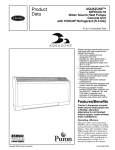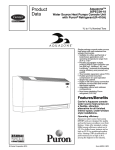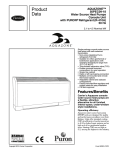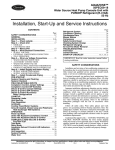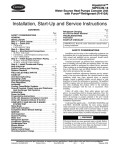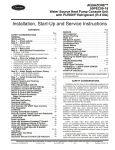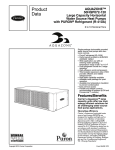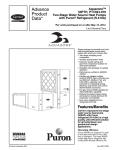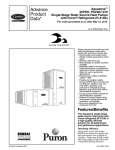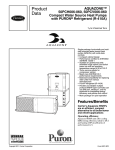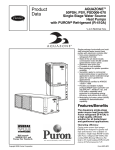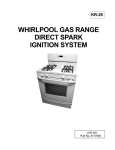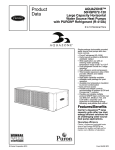Download Carrier AQUAZONE 50PEC09-18 Product data
Transcript
Advance Product Data* Aquazone™ 50PEC09-18 Water Source Heat Pumps Console Unit with Puron® Refrigerant (R-410A) *For units purchased on or after June 23, 2014. 3/ 4 to 11/2 Nominal Tons TM Single-package console water source heat pump with self-contained line voltage thermostats. • Suitable for either geothermal or boiler/tower applications with operating temperature range from 25 F to 110 F. • Thermostatic expansion valve (TXV) • Rubber grommet mounted compressors for quiet operation • Sloped top cabinet • Right or left hand piping connection • Multiple unit-mounted and remote thermostat options • Adaptable cabinet and subbase configurations • Factory-mounted flow regulators and control valves for easy installation • Non-ozone depleting Puron refrigerant (R-410A) Features/Benefits Carrier’s Aquazone console water source heat pumps are a flexible, attractive alternative for all finished interior space, under-window style installations. Operating efficiency Aquazone water source heat pump (WSHP) units are designed for quality and performance excellence over their lifetime. Units offer standard cooling EERs (energy efficiency ratios) up to 13.3 for boiler/tower systems and as high as 22.3 for geothermal applications. Heating COPs (coefficients of performance) are as high as 4.6, among the highest in the industry. Quiet operation The Carrier console WSHP provides exceptionally quiet operation for maximum comfort. © Carrier Corporation 2014 Form 50PEC-1APD Features/Benefits (cont) Design flexibility Aquazone™ console WSHP units are offered in 4 capacity sizes to meet individual zone needs efficiently and effectively. Standard and extended operating range units are available to suit a variety of application requirements. Safe, reliable operation Standard safety features include: high and low pressure monitoring and field selectable water and air coil freeze protection sensing. All safety controls may be reset at the thermostat. Each unit is tested and run at the factory to ensure proper operation of all components and safety switches. All components are carefully designed and selected for endurance, durability, and carefree day-to-day operation. The water-to-refrigerant heat exchanger has copper inner and steel outer tubing which is painted on the outside to provide corrosion resistance protection. Cupronickel heat exchangers are available and should be used on all open loop applications. Units are rated and certified in accordance with AHRI (Air-Conditioning, Heating, and Refrigeration Institute)/ ISO (International Organization for Standardization)/ASHRAE (American Society of Heating, Refrigerating and Air-Conditioning Engineers) 13256-1 performance standard, and are CSA (Canadian Standards Association)/ NRTL (Nationally Recognized Testing Lab) listed. Installation ease The unit is packaged for simple, low cost handling, with minimal time re- quired for installation. The console unit arrives at the jobsite fully assembled to minimize installation time and reduce installation cost. All units are pre-wired and factory charged with Puron® refrigerant (R-410A). Water connections are available in a variety of configurations direct from the factory. The standard configuration is 5/8 in. OD sweat connections for maximum flexibility in the field. Additionally, factory-installed motorized water shutoff valves are available for use on energy conserving systems employing a variable pumping technique. The standard electrical connections are made quickly and directly to a power distribution terminal block. To further improve installation efficiency, a fused or unfused disconnect switch, as well as a 20 amp plug and cord, are available as factory-installed options. A 3/4 in. ID vinyl condensate connection is provided for connection to the field-installed condensate line. Compact cabinet design dimensions are 12 in. deep, 48 in. wide and 24 in. tall. For flexibility, the controls can be mounted on the top right or left side. Additionally, the sloped top design discourages the use of the unit as a shelf, preventing air blockage and any spills from damaging the unit. No-fuss maintenance and serviceability Large service access panels enable quick inspection for problem solving and the control box swings down for easy access to the controls. Fan motor sleeve bearings are permanently lubricated. If the unit requires Table of contents Page Features/Benefits . . . . . . . . . . . . . . . . . . . . . . . . . . . . . . . . . . . . . . . . . . 1-3 Model Number Nomenclature . . . . . . . . . . . . . . . . . . . . . . . . . . . . . . . . . . .4 AHRI/ISO Capacity Ratings . . . . . . . . . . . . . . . . . . . . . . . . . . . . . . . . . . . .5 Physical Data . . . . . . . . . . . . . . . . . . . . . . . . . . . . . . . . . . . . . . . . . . . . . . .5 Options and Accessories . . . . . . . . . . . . . . . . . . . . . . . . . . . . . . . . . . . . . . .6 Dimensions . . . . . . . . . . . . . . . . . . . . . . . . . . . . . . . . . . . . . . . . . . . . . . 7,8 Performance Data . . . . . . . . . . . . . . . . . . . . . . . . . . . . . . . . . . . . . . . . 9-13 Application Data . . . . . . . . . . . . . . . . . . . . . . . . . . . . . . . . . . . . . . . . 14-17 Electrical Data . . . . . . . . . . . . . . . . . . . . . . . . . . . . . . . . . . . . . . . . . . . . .18 Guide Specifications . . . . . . . . . . . . . . . . . . . . . . . . . . . . . . . . . . . . . . 19-21 2 service, an easily removable cabinet and slide-out fan section make access simple. Units are equipped with easily accessible service access ports on both the suction and the discharge refrigerant lines for on-site testing and refrigerant recovery. Filter racks provide easy filter access for cleaning. Maximum control flexibility Aquazone water source heat pumps provide reliable control operation using a standard microprocessor board with flexible alternatives for many direct digital controls (DDC) applications including the Carrier Comfort Network® (CCN) controls and open protocol systems. Carrier’s Aquazone unit solid-state control system, the Complete C, provides control of the unit compressor, reversing valve, fan, safety features, and troubleshooting fault indication features. The Complete C control system is a user friendly, low cost, advanced WSHP control board. Many features are field selectable to maximize flexibility in field installation. The overall features of this control system include: 40-va transformer — Assists in accommodating accessory loads. Anti-short cycle timer — The timer provides a minimum off time to prevent the unit from short cycling. The 5-minute timer energizes when the compressor is deenergized, resulting in a 5-minute delay before the unit can be restarted. Thus, it prevents short cycling of the compressor. Random start relay — The random start relay provides a random delay in energizing each different WSHP unit. This option minimizes peak electrical demand during start-up from different operating modes or after building power outages. The control features a 5 to 80 second random start upon start-up. High and low pressure refrigerant protection — Safeguards against unreliable unit operation and prevents refrigerant from leaking. Condensate overflow sensor — Electronic sensor mounted to the drain pan. When condensate pan liquid reaches an unacceptable level, the unit is automatically deactivated and placed in a lockout condition. The sensor recognizes thirty continuous seconds of overflow as a fault condition. High and low voltage protection — Safety protection for excessive or low voltage conditions. Automatic intelligent reset — Unit shall automatically restart 5 minutes after shutdown if the fault has cleared. Should a fault occur 3 times sequentially, lockout will occur. Accessory output — In applications such as variable speed pumping, a 24-v output cycles a motorized water valve or damper actuator with compressor. Performance monitor (PM) — This feature monitors water temperatures to warn when the heat pump is operating inefficiently or beyond typical operating range. A field selectable switch initiates a warning code on the unit display. Water coil freeze protection (selectable for water or antifreeze) — Field selectable switch for water and water/glycol solution systems initiates a fault when temperatures exceed the selected limit for 30 continuous seconds. Air coil freeze protection (check filter operation) — Field selectable switch for assessing excessive filter pressure drop initiates a fault when temperatures exceed the selected limit for 30 continuous seconds. Alarm relay setting — Selectable 24-v or pilot duty dry contact provides remote alarm activation. Service Test mode with diagnostic LED (light-emitting diode) — Test mode allows service personnel to check the operation of the WSHP and control system efficiently. Upon entering Test mode, time delays speed up, and the Status LED flashes a code indicating the last fault. This mode provides an easy fault diagnosis, based on the fault code that the status LED flashes. Carrier-provided troubleshooting tables provide an easy reference to typical problems. LED visual output — An LED panel indicates high pressure, low pressure, low voltage, high voltage, air/water freeze protection, condensate overflow, and control status. Puron® refrigerant (R-410A) Puron refrigerant (R-410A) is a nonchlorine based enviromentally balanced, non-ozone depleting refrigerant. Puron refrigerant characteristics, compared to R-22, have: • Binary and near azeotropic mixture of 50% R-32 and 50% R-125. • Higher efficiencies (50 to 60% higher operating pressures). • Virtually no glide. Unlike other alternative refrigerants, the two components in Puron refrigerant have virtually the same leak rates. * Sponsored by ASHRAE (American Society of Heating, Refrigerating and Air Conditioning Engineers. † Registered trademark of Schneider Electric. 3 Model number nomenclature 50PEC 12 X C C C 1 A P C A Factory Installed Options Model Series Standard Cleanable Mesh Filter 50PEC – Aquazone™ High Efficiency Water Source Heat Pump with Puron® Refrigerant (R-410A) 09 12 15 18 – 3/4 – 1 – 11/4 – 11/2 Water Circuit Options A – 5/8 in. Sweat, Right H – 1/2 in. FPT Fitting, Right T – 1/2 in. FPT Fitting, Left X – 5/8 in. Sweat, Left 1 A Operating Range/Sound Option A – Extended Range Packaging 1 – Domestic A Cabinet and Subbase Options A – Standard 63 in. Cabinet and Subbase T – No Cabinet and Standard Subbase X – Standard 48 in. Cabinet and Subbase W – No Cabinet and No Subbase Voltage 0 – 115-1-60 3 – 208/230-1-60 4 – 277-1-60 B – 115-1-60 with Disconnect C – 208/230-1-60 with Disconnect D – 277-1-60 with Disconnect L – Standard C Microprocessor Control Package with Remote Thermostat R – Standard D Microprocessor Control Package with Remote Thermostat U – Unit Mounted Controller Refrigerant Circuit Options E – Cu, Coated J – CuNi, Coated LEGEND Cu — Copper CuNi — Copper Nickel OA — Outdoor Air 4 Std (No OA Damper) OA Damper AHRI/ISO capacity ratings 50PEC UNIT SIZE FLUID FLOW RATE gpm 09 12 15 18 COP db EER wb — — — — 2.0 2.5 4.0 5.0 WATER LOOP HEAT PUMP Cooling 86 F Capacity Btuh 8,200 10,500 14,400 16,400 EER 12.9 12.0 13.3 12.3 GROUND WATER HEAT PUMP Heating 68 F Capacity Btuh 9,400 12,400 15,000 17,500 COP 4.6 4.3 4.3 4.2 Cooling 59 F Capacity Btuh 10,200 13,000 16,400 18,300 LEGEND Coefficient of Performance Dry Bulb Temperature Energy Efficiency Ratio Wet Bulb Temperature EER 22.3 19.4 19.8 17.6 Heating 50 F Capacity Btuh 7,400 10,900 11,800 14,600 COP 3.8 3.8 3.6 3.4 GROUND LOOP HEAT PUMP Cooling 77 F Capacity Btuh 9,000 11,500 14,700 17,000 EER 16.0 14.2 14.5 14.0 Heating 32 F Capacity Btuh 5,400 8,400 9,800 12,000 COP 3.3 3.3 3.3 3.1 NOTES: 1. Ratings are in accordance with and certified to AHRI/ISO Standard 13256-1. 2. Cooling capacities based upon 80.6 F db, 66.2 F wb entering air temperature. 3. Heating capacities based upon 68 F db, 59 F wb entering air temperature. Physical data BASE UNIT 50PEC COMPRESSOR (1 each) Maximum Water Working Pressure (psig/kPa) 09 Rotary 12 Rotary 15 Rotary 18 Rotary 400/3100 400/3100 400/3100 400/3100 PSC/2 PSC/2 PSC/2 PSC/2 1/10 1/10 1/4 PSC Fan Motor and Blower Fan Motor Type/Speeds Fan Motor (hp) Blower Wheel Size (Dia x W) (in.) (qty) 5.5 x 8.0 (X 2) WATER CONNECTION SIZE (in.) 0.15 Coaxial Coil Volume (gal) Condensate Connection in. FPT 5.5 x 8.0 (X 2) 5.5 x 8.0 (X 2) 5/8 in. Sweat (Optional 1/2 in. FPT) 3/ 4 ID (1 OD) 0.15 3/ 4 ID (1 OD) 1/4 5.5 x 8.0 (X 2) 0.31 3/ 4 ID (1 OD) 0.31 3/ 4 ID (1 OD) VERTICAL CABINET Refrigeration Charge (oz) Air Coil Dimensions (H x L) 19 22 23 23 10 x 27 10 x 27 10 x 27 10 x 27 7 x 311/4 x 3/8 7 x 311/4 x 3/8 7 x 311/4 x 3/8 7 x 311/4 x 3/8 Weight - Operating (lbs) 131 138 144 144 Weight - Shipping (lbs) 151 158 164 164 Std. Filter - 1/2" Washable Aluminum (H x L) LEGEND FPT — Female Pipe Thread PSC — Permanent Split Capacitor 5 Options and accessories Factory-wired options Factory-installed options Unit mounted controller is a factory-wired option. The standard unit mounted controller provides a tactile touchpad for temperature, fan and mode adjustment as shown. Temperature is read in a digital display, with an LED display indicating unit operating mode, as well as fan speed and fault indication for high or low pressure lockout. Temperature set points are adjustable from 60 F to 80 F, with an adjustable temperature differential between 1 F and 6 F. Selectable options include manual or automatic changeover, high or low fan speed as well as constant fan operation or fan operation to cycle with the compressor. Additional features include a 5 minute anti short cycling delay, random start, 90 second low pressure bypass timer and intelligent reset to allow the unit to automatically restart after 5 minutes if a fault is no longer active. Cupronickel heat exchangers are available for higher corrosion protection for applications such as open tower, geothermal, etc. Consult the water quality guidelines for proper application and selection of this option. Thermostat options include auto changeover (ACO) thermostat. The thermostat sends the appropriate signal to the controller for cooling or heating mode of operation. Options R and L allow connection to a remote wallmounted thermostat. The controller requires a heat pump thermostat. The controller can be configured for heat pump or heat/cool thermostat. Piping connections can be provided on either the right or left hand side of the unit, for easy installation. Orientation is determined by facing the unit from the front side. UNIT MOUNTED CONTROL 6 Field-installed accessories Aquazone system control panel includes a preprogrammed, easy to use, Carrier Comfort Controller set up for a WSHP system. • Coordinates, monitors, and controls all WSHP units and ancillary equipment including cooling towers, boilers, and system pumps. • 50RLP model nomenclature is used to customize the panel to control all WSHP system requirements. • Panel can be ordered to include 2, 4, 6, or 8 stages of system heat rejection. • Panel can be ordered to include 2, 4, 6, or 8 stages of system heat addition. • Panel can be ordered with unique WSHP zone operation capabilities for stand alone systems (i.e., non-communicating) to control 10 or 18 zones of WSHP units. • Panel can be ordered to control variable frequency cooling tower fan operation. • System pumping operation can be configured for start/ stop, lead/lag, or variable frequency pump operation. • Direct digital controls (DDC) are compatible using the BACnet and WSHP units using WSHP Open. Dimensions 50PEC09-18 UNIT CONSOLE 2.875 LEFT HAND WATER CONNECTIONS RIGHT HAND WATER CONNECTIONS 6.00 45.00 45.00 6.00 6.125 23.875 12.875 30.75 3.375 48.00 15.875 48.00 30.75 11.00 12.00 NOTES: All dimensions within ± 0.125". Filter size: 7" x 30 1/4" x 3/8" Aluminum Mesh 7 Dimensions (cont) 50PEC09-18 UNIT CHASSIS LEFT HAND WATER 42.75 11.00 8.00 1.38 12.00 0.75 Water Out 1.00 2.75 2.00 Water In 19.56 Condensate Water 15.63 13.75 13.50 5.00 1.75 3.38 1.63 RIGHT HAND WATER Disconnect Switch 0.75 42.75 11.00 4.88 8.00 2.75 Disconnect Switch 0.75 2.00 Water In 15.63 1.00 Water Out 15.00 13.75 8.69 Condensate Water 4.00 7.31 NOTES: 1. All dimensions are within ± 0.125 inch. 2. Console units must be installed with a cabinet and subbase. 3. Filter size: 7 x 30-1/8 x 38-in. Aluminum Mesh 4. Unit controller shown, other control options may have a different control panel configuration. 5. Specifications subject to change without notice. 8 Performance data 50PEC09 — COOLING, NOMINAL AIRFLOW 350 CFM, 2.0 GPM EWT (F) Entering Air Temp (F) Total Capacity (MBtuh) 50 60 70 85 100 50 60 70 85 100 50 60 70 85 100 50 60 70 85 100 9.35 8.72 8.10 7.16 6.22 10.01 9.34 8.67 7.66 6.65 10.97 10.24 9.50 8.40 7.29 11.94 11.14 10.34 9.14 7.93 70° db 61° wb 75° db 63° wb 80° db 67° wb 85° db 71° wb Sensible Capacity (MBtuh) Sensible to Total Ratio 6.22 5.86 5.50 4.99 4.49 7.42 6.98 6.56 5.95 5.34 8.17 7.69 7.22 6.55 5.89 8.94 8.41 7.90 7.17 6.44 0.67 0.67 0.68 0.70 0.72 0.74 0.75 0.76 0.78 0.80 0.74 0.75 0.76 0.78 0.81 0.75 0.75 0.76 0.78 0.81 Power Input (kW) Heat of Rejection (MBtuh) EER 0.38 10.66 24.4 0.45 10.25 19.5 0.51 0.60 0.70 0.39 0.45 0.51 0.61 0.70 0.39 0.45 0.52 0.61 0.71 0.39 0.46 0.52 0.62 0.72 9.84 9.22 8.60 11.33 10.87 10.42 9.74 9.05 12.30 11.78 11.27 10.49 9.71 13.27 12.69 12.11 11.25 10.38 15.9 11.8 8.9 26.0 20.8 16.9 12.6 9.5 28.2 22.6 18.4 13.7 10.3 30.5 24.4 19.8 14.8 11.1 50PEC09 — HEATING, NOMINAL AIRFLOW 350 CFM, 2.0 GPM EWT (F) Entering Air Temp (F) Total Capacity (MBtuh) 50 60 70 7.74 8.90 10.06 11.22 7.31 8.41 9.50 10.60 6.81 7.83 8.85 9.87 60° 80 50 60 70 70° 80 50 60 70 80° 80 Power Input (kW) Heat of Abs. (MBtuh) COP 0.53 5.92 4.3 0.57 6.96 4.6 0.60 0.64 0.54 0.58 0.61 0.65 0.56 0.59 0.63 0.67 8.00 9.04 5.46 6.43 7.41 8.38 4.91 5.81 6.71 7.60 4.9 5.2 3.9 4.3 4.5 4.8 3.6 3.9 4.1 4.3 50PEC09 — LOW TEMPERATURE HEATING*, NOMINAL AIRFLOW 350 CFM, 2.0 GPM EWT (F) Entering Air Temp (F) Total Capacity (MBtuh) Power Input (kW) Heat of Abs. (MBtuh) 4.74 5.31 6.45 4.48 5.01 6.09 4.17 4.67 5.67 0.44 3.22 3.1 0.46 3.73 3.4 0.50 0.45 0.47 0.51 0.46 0.48 0.52 4.75 2.93 3.41 4.36 2.59 3.02 3.90 3.8 2.9 3.1 3.5 2.6 2.8 3.2 25 30 40 60° 25 30 40 70° 25 30 40 80° COP * Antifreeze required. LEGEND COP — Coefficient of Performance db — Dry Bulb Temperature EER — Energy Efficiency Ratio EWT — Entering Water Temperature MBtuh — Btuh in Thousands wb — Wet Bulb Temperature 9 Performance data (cont) 50PEC12 — COOLING, NOMINAL AIRFLOW 450 CFM, 2.5 GPM EWT (F) Entering Air Temp (F) Total Capacity (MBtuh) 50 60 70 11.90 11.12 10.33 9.16 7.98 12.74 11.90 11.06 9.80 8.54 13.97 13.05 12.13 10.75 9.37 15.19 14.19 13.19 11.69 10.19 70° db 61° wb 85 100 50 60 70 75° db 63° wb 85 100 50 60 70 80° db 67° wb 85 100 50 60 70 85° db 71° wb 85 100 Sensible Capacity (MBtuh) Sensible to Total Ratio 7.92 7.46 7.02 6.39 5.76 9.44 8.89 8.37 7.61 6.86 10.40 9.80 9.22 8.39 7.56 11.37 10.71 10.08 9.17 8.27 0.67 0.67 0.68 0.70 0.72 0.74 0.75 0.76 0.78 0.80 0.74 0.75 0.76 0.78 0.81 0.75 0.75 0.76 0.78 0.81 Power Input (kW) Heat of Rejection (MBtuh) EER 0.58 13.88 20.5 0.65 13.35 17.0 0.73 0.84 0.95 0.58 0.66 0.73 0.84 0.96 0.59 0.66 0.74 0.85 0.96 0.59 0.67 0.74 0.86 0.97 12.82 12.02 11.23 14.73 14.15 13.56 12.69 11.81 15.98 15.31 14.65 13.65 12.66 17.22 16.48 15.73 14.62 13.51 14.2 10.9 8.4 21.8 18.1 15.1 11.6 8.9 23.7 19.7 16.4 12.6 9.7 25.6 21.2 17.7 13.6 10.5 50PEC12 — HEATING, NOMINAL AIRFLOW 450 CFM, 2.5 GPM EWT (F) Entering Air Temp (F) Total Capacity (MBtuh) 50 60 70 11.05 12.21 13.37 14.53 10.44 11.53 12.63 13.73 9.72 10.74 11.76 12.79 60° 80 50 60 70 70° 80 50 60 70 80° 80 Power Input (kW) Heat of Abs. (MBtuh) COP 0.78 8.38 4.1 0.81 9.43 4.4 0.84 0.87 0.80 0.83 0.86 0.89 0.82 0.85 0.88 0.91 10.49 11.54 7.72 8.71 9.70 10.68 6.94 7.85 8.76 9.67 4.6 4.9 3.8 4.1 4.3 4.5 3.5 3.7 3.9 4.1 50PEC12 — LOW TEMPERATURE HEATING*, NOMINAL AIRFLOW 450 CFM, 2.5 GPM EWT (F) Entering Air Temp (F) Total Capacity (MBtuh) Power Input (kW) Heat of Abs. (MBtuh) 7.98 8.55 9.69 7.54 8.08 9.16 7.02 7.52 8.53 0.70 5.58 3.3 0.72 6.10 3.5 0.75 0.72 0.73 0.77 0.73 0.75 0.78 7.13 5.09 5.58 6.54 4.52 4.96 5.85 3.8 3.1 3.2 3.5 2.8 2.9 3.2 25 60° 30 40 25 70° 30 40 25 80° 30 40 * Antifreeze required. COP db EER EWT MBtuh wb 10 — — — — — — LEGEND Coefficient of Performance Dry Bulb Temperature Energy Efficiency Ratio Entering Water Temperature Btuh in Thousands Wet Bulb Temperature COP 50PEC15 — COOLING, NOMINAL AIRFLOW 550 CFM, 4.0 GPM EWT (F) Entering Air Temp (F) Total Capacity (MBtuh) 50 60 70 14.79 14.08 13.37 12.31 11.24 15.83 15.07 14.31 13.17 12.03 17.35 16.52 15.69 14.44 13.19 18.88 17.97 17.07 15.71 14.35 70° db 61° wb 85 100 50 60 70 75° db 63° wb 85 100 50 60 70 80° db 67° wb 85 100 50 60 70 85° db 71° wb 85 100 Sensible Capacity (MBtuh) 9.84 9.45 9.09 8.58 8.11 11.73 11.26 10.82 10.22 9.66 12.92 12.41 11.93 11.27 10.65 14.13 13.57 13.04 12.32 11.65 Sensible to Total Ratio 0.67 0.67 0.68 0.70 0.72 0.74 0.75 0.76 0.78 0.80 0.74 0.75 0.76 0.78 0.81 0.75 0.75 0.76 0.78 0.81 Power Input (kW) Heat of Rejection (MBtuh) EER 0.72 17.26 20.5 0.81 16.86 17.3 0.90 1.04 1.18 0.73 0.82 0.91 1.05 1.18 0.73 0.83 0.92 1.06 1.19 0.74 0.83 0.92 1.06 1.20 16.46 15.86 15.26 18.30 17.86 17.42 16.74 16.07 19.86 19.34 18.82 18.04 17.27 21.40 20.81 20.22 19.34 18.46 14.8 11.8 9.6 21.8 18.4 15.7 12.6 10.2 23.7 20.0 17.1 13.7 11.1 25.5 21.6 18.5 14.8 11.9 50PEC15 — HEATING, NOMINAL AIRFLOW 550 CFM, 4.0 GPM EWT (F) Entering Air Temp (F) Total Capacity (MBtuh) 50 60 70 12.75 14.26 15.77 17.28 12.05 13.48 14.90 16.33 11.22 12.55 13.88 15.21 60° 80 50 60 70 70° 80 50 60 70 80° 80 Power Input (kW) Heat of Abs. (MBtuh) COP 0.92 9.61 4.1 0.96 10.98 4.3 1.00 1.04 0.94 0.98 1.02 1.06 0.96 1.00 1.04 1.09 12.36 13.73 8.84 10.13 11.42 12.71 7.94 9.13 10.31 11.50 4.6 4.9 3.8 4.0 4.3 4.5 3.4 3.7 3.9 4.1 50PEC15 — LOW TEMPERATURE HEATING*, NOMINAL AIRFLOW 550 CFM, 4.0 GPM EWT (F) Entering Air Temp (F) Total Capacity (MBtuh) Power Input (kW) Heat of Abs. (MBtuh) 8.80 9.54 11.02 8.32 9.02 10.41 7.75 8.40 9.70 0.82 6.00 3.1 0.84 6.67 3.3 0.88 0.84 0.86 0.90 0.86 0.88 0.92 8.01 5.46 6.09 7.35 4.82 5.40 6.56 3.7 2.9 3.1 3.4 2.6 2.8 3.1 25 60° 30 40 25 70° 30 40 25 80° 30 40 COP * Antifreeze required. COP db EER EWT MBtuh wb — — — — — — LEGEND Coefficient of Performance Dry Bulb Temperature Energy Efficiency Ratio Entering Water Temperature Btuh in Thousands Wet Bulb Temperature 11 Performance data (cont) 50PEC18 — COOLING, NOMINAL AIRFLOW 600 CFM, 5.0 GPM EWT (F) Entering Air Temp (F) Total Capacity (MBtuh) Sensible Capacity (MBtuh) 16.26 15.65 15.05 14.14 13.23 17.40 16.76 16.11 15.13 14.16 19.08 18.37 17.66 16.59 15.52 20.76 19.98 19.21 18.04 16.88 10.82 10.51 10.23 9.86 9.54 12.89 12.52 12.18 11.74 11.37 14.21 13.79 13.42 12.94 12.53 15.54 15.08 14.68 14.15 13.70 50 60 70 70° db 61° wb 85 100 50 60 70 75° db 63° wb 85 100 50 60 70 80° db 67° wb 85 100 50 60 70 85° db 71° wb 85 100 Sensible to Total Ratio 0.67 0.67 0.68 0.70 0.72 0.74 0.75 0.76 0.78 0.80 0.74 0.75 0.76 0.78 0.81 0.75 0.75 0.76 0.78 0.81 Power Input (kW) Heat of Rejection (MBtuh) EER 0.91 19.36 17.9 1.01 19.11 15.5 1.12 1.27 1.43 0.91 1.02 1.12 1.28 1.44 0.92 1.03 1.13 1.29 1.45 0.93 1.03 1.14 1.30 1.46 18.87 18.47 18.09 20.52 20.23 19.94 19.50 19.06 22.22 21.87 21.52 20.99 20.46 23.93 23.51 23.10 22.48 21.86 13.5 11.1 9.3 19.1 16.5 14.4 11.8 9.9 20.7 17.9 15.6 12.9 10.7 22.3 19.3 16.8 13.9 11.6 50PEC18 — HEATING, NOMINAL AIRFLOW 600 CFM, 5.0 GPM EWT (F) Entering Air Temp (F) Total Capacity (MBtuh) 50 60 70 15.37 16.96 18.56 20.16 14.52 16.03 17.54 19.04 13.52 14.93 16.33 17.74 60° 80 50 60 70 70° 80 50 60 70 80° 80 Power Input (kW) Heat of Abs. (MBtuh) COP 1.16 11.39 3.9 1.19 12.89 4.2 1.22 1.25 1.19 1.22 1.25 1.28 1.21 1.25 1.28 1.31 14.38 15.88 10.47 11.87 13.28 14.68 9.37 10.67 11.97 13.27 4.4 4.7 3.6 3.9 4.1 4.4 3.3 3.5 3.7 4.0 50PEC18 — LOW TEMPERATURE HEATING*, NOMINAL AIRFLOW 600 CFM, 5.0 GPM EWT (F) Entering Air Temp (F) Total Capacity (MBtuh) Power Input (kW) Heat of Abs. (MBtuh) 11.15 11.93 13.50 10.54 11.27 12.75 9.81 10.50 11.88 1.09 7.43 3.0 1.11 8.16 3.2 1.13 1.11 1.13 1.16 1.14 1.15 1.18 9.63 6.74 7.43 8.81 5.93 6.57 7.84 3.5 2.8 2.9 3.2 2.5 2.7 2.9 25 60° 30 40 25 70° 30 40 25 80° 30 40 * Antifreeze required. COP db EER EWT MBtuh wb 12 — — — — — — LEGEND Coefficient of Performance Dry Bulb Temperature Energy Efficiency Ratio Entering Water Temperature Btuh in Thousands Wet Bulb Temperature COP SOUND DATA — SOUND POWER LEVEL, CASING RADIATED OCTAVE BAND SOUND POWER LEVELS db, RE 10-12 WATTS 50PEC UNIT 125 250 500 1000 2000 4000 8000 09 64.5 59.0 47.0 43.0 34.0 30.0 27.5 AHRI Sound Rating Bels 5.643 12 65.0 57.5 52.0 44.0 37.0 32.5 27.5 6.008 15 61.5 60.5 53.5 49.5 42.5 39.5 35.0 6.069 18 69.5 62.0 54.5 51.0 45.0 39.5 34.0 6.363 13 Application data Aquazone™ water source heat pump products are available in a flexible, efficient array of models, which can be used in all types of water loop, ground water, and ground loop type systems. Use Aquazone products to provide optimal energy efficient solutions and adapt to the most challenging design requirements. AQUAZONE PRODUCT GUIDE 50 SERIES 50HQP,VQP TYPE SIZE (tons) Large Capacity 6-10 (HQP) 61/2-25 (VQP) 50PC Compact 11/4-5 50PS Premium Efficiency 1/ -6 2 High Efficiency Console 3/ -11/ 4 2 Premium Efficiency 2-6 50PEC 50PT 50PSW Water-to-Water 3-28 APPLICATION Environmentally sound unit with Puron® refrigerant (R-410A) designed to handle large zoned areas for all geothermal and boiler/tower applications. Compact WSHP with Puron refrigerant (R-410A) for boiler/tower, ground water, or ground loop systems. Premium, ultra efficient unit with Puron refrigerant (R-410A) for new boiler/tower, ground water, or ground loop systems. Efficient console unit with Puron refrigerant (R-410A) and attractive design for finished interior, under-window installations. Premium, ultra efficient 2-stage unit with Puron refrigerant (R-410A) for new boiler/ tower, ground water, or ground loop systems. Efficient unit with Puron refrigerant (R-410A) serves as an alternative to preheat or cool air. Unit can be used as a stand-alone or supplemental boiler/chiller in most hydronic heating applications. Also conditions process fluids, lubricants, and refrigerants. Water loop system Water loop (or boiler/tower) system applications typically include a number of units plumbed to a common piping system. For optimal performance, design this system between 2.25 and 3 gpm per ton of cooling capacity. The system is comprised of highly efficient, packaged, reverse cycle heat pump units, interconnected by a water loop. The water circuit serves as both a sink and source for heat absorption and rejection and is designed for entering water temperatures between 50 F and 100 F. Within this temperature range, units can heat or cool from the same water source. Transferring heat from warm to cold spaces in the building, whenever they coexist, conserves energy rather than creating new heat. Refer to the Carrier Water Source Heat Pump System Design Guide for assistance designing water loop systems. The guide includes a practical approach for the latest and most current design recommendations including: • Horizontal, vertical, console, rooftop and water-towater product applications. • Ventilation methods and system design, including energy recovery. • Acoustical considerations for different product types. • Addressing IAQ issues such as condensate removal, humidity control. • Air distribution design, including diffuser selection/ layout and ductwork design. • Hydronic system design, including pipe sizing/layout and boiler/tower sizing. • Control configurations such as stand alone, DDC, DCV, and VVT®. • WSHP efficiency/operational cost comparison chart. 14 • System variations such as a system without a boiler, variable pumping, and VAV for interior use. Ground water systems To use Aquazone units in ground water applications, the extended range should be specified. This will provide factory-installed coaxial coil insulation to prevent condensate from dripping when entering water temperatures are below 50 F. In addition, the copper coaxial coil installed on the Aquazone units may not be suitable for all water conditions. Refer to the Water Conditioning section for proper coaxial coil material selection. Surface water system — This system is typically located near a lake or pond. In this application, the loop can be submerged in a series of coils beneath the water surface. The number of coils required depends on system load and design. This application requires minimum piping and excavation. Open loop system — Use this system where ground water is plentiful. In this application, ground water is pumped through supply piping from the well to the building. The water is then pumped back into the ground through a discharge well as it leaves the building. An additional heat exchanger is usually installed between the building water piping system and the ground water piping system. This design limits piping and excavation. Aquazone units are rated to extremely low temperatures to self-adjust the refrigeration circuit. Therefore, open loop systems do not require water regulating valves. Use a slow opening/closing solenoid valve to conserve water. Ground loop systems There are many commonly specified designs for ground loop applications. Typical designs include vertical loops and horizontal loops. In some applications, water is piped from the ground or lake directly to the water source heat pump. This system only requires piping to get the water from the source to the unit. NOTE: When using Aquazone water source heat pumps in ground loop systems, refer to the design considerations in the ground water system section. Horizontal ground loop — Use this system when adequate space is available and trenching can be easily accomplished. A series of parallel pipes are laid out in trenches 3 to 6 feet below the ground surface, and then back-filled. Often, multiple pipes are used to maximize each trench’s heat transfer capability. Ground conditions, heating and cooling requirements, and system design determine piping requirements and ground loop field size. Vertical ground loop — Use this system in vertical borehole applications. This design is well suited for retrofit applications when space is limited or where landscaping is already complete and minimum site disruption is desired. The vertical ground loop system contains a single loop of pipe inserted into a hole. The hole is back-filled and grouted after the pipe is inserted. The completed loop is concealed below ground. The number of loops required depends on ground conditions, heating and cooling requirements, and the depth of each hole. Hybrid systems — In some applications, it may be beneficial to incorporate a cooling tower into the ground loop system to reduce the overall cost. A hybrid system discards excess heat into the air and increases the cooling performance of the ground loop. Condensate drainage Connect the console unit condensate drain to the building condensate drain with a flexible, non-pressure rated plastic hose. Be sure to avoid kinks in this hose to ensure an unobstructed flow of condensate from the unit to the drain. The condensate hose’s horizontal run is usually too short to pose any drainage problems; however, make sure this line is pitched at least 1 in. for every 10 ft of run (in the direction of the flow.) Avoid low points and unpitched piping since dirt collects in these areas and may cause stoppage and overflow. Installing a trap or drain in the field is not required unless specified by local codes. The 50PEC units are designated in a blow-thru configuration. The condensate drain pan is located on the outlet side of the blower so that the pressure in the drain pan is higher than the atmospheric pressure. Water conditioning In some applications, maintaining proper water quality may require higher corrosion protection for the water-torefrigerant heat exchanger. Water quality varies from location to location and is unique for each job. Water characteristics such as pH value, alkalinity, hardness, and specific conductance are important when considering any WSHP application. Water typically includes impurities and hardness that must be removed. The required treatment depends on the water quality, as well as the system type. Water problems fall into three main categories: 1. Scale formation caused by hard water reduces the heat transfer rate and increases the water pressure drop through the heat exchanger. As water is heated, minerals and salts are precipitated from a solution and deposited on the inside surface of the pipe or tube. 2. Corrosion is caused by absorption of gases from the air coupled with water on exposed metal. Corrosion is also common in salt-water areas. 3. Organic growths, such as algae, can reduce the heat transfer rate by forming an insulating coating on the inside tube surface. Algae can also promote corrosion by pitting. NOTE: In most commercial water loop applications, Aquazone™ WSHP units use a copper, water-to-refrigerant heat exchanger. Units can also be equipped with a cupronickel heat exchanger for applications where water is outside the copper heat exchanger’s standard contaminant limits. Acoustical design Sound power levels represent the sound that the source, the WSHP unit, produces with no regard to attenuation between the source and the space. Acoustical design goals are necessary to provide criteria for occupied spaces. These goals help ensure that people can be comfortable and communicate effectively over the background noise of the air-conditioning system and other background noise sources. Acoustical design goals are desirable sound pressure levels within a given conditioned space and are represented by noise criteria (NC) curves. Noise criteria (NC) curve levels represent a peak over a full frequency spectrum. A high value in a low frequency band has the same effect on NC level as a lower value in a high frequency band. It is important that sound levels be balanced over the entire spectrum relative to the NC curve. The lower the NC criteria curve, the more stringent the room acoustical design must be to meet the design goals. It is important to know how to convert the unit ratings from sound power (Lw) to sound pressure (Lp). This conversion depends on the specifics of the installation’s acoustical environment. Assessing an area’s acoustical design requires that you compare the sound pressure (Lp) with the NC curve for the selected area. The resulting calculations are compared to the NC curve selected for the area to assess the acoustical design. Some of the factors that affect conversion of sound power to sound pressure and consequent NC level include: • Type of acoustical ceiling • Use of metal or flex duct • Absorption in the occupied space • Location in the occupied space • Open or closed layout plan • Use of open or ducted returns • Orientation of unit to occupant • Use of lined or unlined duct OCTAVE BAND SOUND PRESSURE LEVEL (Lp) ASSOCIATED WITH NC CURVES NOISE CRITERIA CURVES NC-15 NC-20 NC-25 NC-30 NC-35 NC-40 NC-45 NC-50 NC-55 NC-60 NC-65 OCTAVE BAND SOUND PRESSURE LEVEL (Lp) Frequency (Hz) 63 125 250 500 1000 2000 4000 8000 49 36 26 17 17 14 12 11 52 41 33 27 22 19 17 16 54 45 38 31 27 24 22 21 58 49 41 36 31 29 28 27 61 53 45 40 36 34 33 32 64 57 50 45 41 39 38 37 67 61 54 49 46 44 43 42 71 64 58 54 51 49 48 47 74 68 63 58 56 54 53 52 77 71 67 63 61 59 58 57 80 75 71 68 66 64 63 62 15 Application data (cont) WATER QUALITY GUIDELINES CONDITION HX MATERIAL* CLOSED RECIRCULATING† OPEN LOOP AND RECIRCULATING WELL** Scaling Potential — Primary Measurement Above the given limits, scaling is likely to occur. Scaling indexes should be calculated using the limits below. pH/Calcium All N/A pH < 7.5 and Ca Hardness, <100 ppm Hardness Method Index Limits for Probable Scaling Situations (Operation outside these limits is not recommended.) Scaling indexes should be calculated at 150 F for direct use and HWG applications, and at 90 F for indirect HX use. A monitoring plan should be implemented. Ryznar Stability Index 6.0 - 7.5 All N/A If >7.5 minimize steel pipe use. Langelier Saturation Index –0.5 to +0.5 All N/A If <–0.5 minimize steel pipe use. Based upon 150 F HWG and direct well, 85 F indirect well HX. Iron Fouling Iron Fe2+ (Ferrous) <0.2 ppm (Ferrous) All N/A (Bacterial Iron Potential) If Fe2+ (ferrous) >0.2 ppm with pH 6 - 8, O2<5 ppm check for iron bacteria. Iron Fouling <0.5 ppm of Oxygen All N/A Above this level deposition will occur. Corrosion Prevention†† pH 6 - 8.5 6 - 8.5 All Monitor/treat as needed. Minimize steel pipe below 7 and no open tanks with pH <8. <0.5 ppm Hydrogen Sulfide (H2S) At H2S>0.2 ppm, avoid use of copper and cupronickel piping or HXs. All N/A Rotten egg smell appears at 0.5 ppm level. Copper alloy (bronze or brass) cast components are okay to <0.5 ppm. Ammonia Ion as Hydroxide, <0.5 ppm Chloride, Nitrate and Sulfate All N/A Compounds Maximum Chloride Levels Maximum allowable at maximum water temperature. 50 F (10 C) 75 F (24 C) 100 F (38 C) Copper N/A <20 ppm NR NR Cupronickel N/A <150 ppm NR NR 304 SS N/A <400 ppm <250 ppm <150 ppm 316 SS N/A <1000 ppm <550 ppm <375 ppm Titanium N/A >1000 ppm >550 ppm >375 ppm Erosion and Clogging Particulate Size and Erosion <10 ppm of particles and a maximum velocity of 6 fps. <10 ppm (<1 ppm “sandfree” for reinjection) of particles and a maximum All velocity of 6 fps. Filtered for maximum 800 micron size. Any particulate that Filtered for maximum is not removed can potentially clog components. 800 micron size. Brackish Use cupronickel heat exchanger when concentrations of calcium or All N/A sodium chloride are greater than 125 ppm are present. (Seawater is approximately 25,000 ppm.) LEGEND HWG — Hot Water Generator HX — Heat Exchanger N/A — Design Limits Not Applicable Considering Recirculating Potable Water NR — Application Not Recommended SS — Stainless Steel *Heat exchanger materials considered are copper, cupronickel, 304 SS (stainless steel), 316 SS, titanium. †Closed recirculating system is identified by a closed pressurized piping system. **Recirculating open wells should observe the open recirculating design considerations. 16 ††If the concentration of these corrosives exceeds the maximum allowable level, then the potential for serious corrosion problems exists. Sulfides in the water quickly oxidize when exposed to air, requiring that no agitation occur as the sample is taken. Unless tested immediately at the site, the sample will require stabilization with a few drops of one Molar zinc acetate solution, allowing accurate sulfide determination up to 24 hours after sampling. A low pH and high alkalinity can cause system problems, even when both values are within ranges shown. The term pH refers to the acidity, basicity, or neutrality of the water supply. Below 7.0, the water is considered to be acidic. Above 7.0, water is considered to be basic. Neutral water registers a pH of 7.0. To convert ppm to grains per gallon, divide by 17. Hardness in mg/l is equivalent to ppm. WSHP sound control Analyzing the projected sound level in the conditioned space caused by a WSHP unit is quite involved. The key is to have good sound power ratings (Lw) in dB on the equipment to determine the ductwork, ceiling and room sound attenuation effect. Console units With console units, the fan and compressor are located within the space, and only the casing design attenuates the transmission of sound sources into the space. The designer should carefully review the manufacturer’s acoustical data when selecting console units and use lower fan speeds to minimize space noise. Operating limits Environment This equipment is designed for indoor installation ONLY. Power supply A voltage variation of ± 10% of nameplate utilization voltage is acceptable. AIR LIMITS AIR LIMITS COOLING Minimum ambient air temperature F Maximum ambient air temperature F Minimum evaporator entering air db/wb F Rated air coil entering air db/wb F Maximum evaporator entering air db/wb F Minimum water coil entering fluid temperature F Water loop typical coil entering fluid range temperature F Maximum water coil entering fluid temperature F HEATING Minimum ambient air temperature F Maximum ambient air temperature F Minimum evaporator entering air db F Rated air coil entering air F Maximum evaporator entering air db F Normal water coil entering fluid range F Minimum water coil entering Fluid F EXTENDED RANGE OPTION 50 100 68/57 80/67 98/85 50 70/90 110 40 85 50 68 80 25-80* 20* LEGEND db — Dry Bulb wb — Wet Bulb *Antifreeze solution is required at these fluid temperatures. Starting conditions Freeze protection The 50PEC unit will start and operate in an ambient temperature of 50 F, with entering-air temperature at 50 F, with entering-water temperature at 60 F, with both air and water at the flow rates used in the AHRI/ISO Standard 13256-1 rating test, for initial start-up in winter. NOTE: These are not normal or continuous operating conditions. Such a start-up should be used to bring the building space up to occupancy temperature. Applications where systems are exposed to outdoor temperatures below freezing (32 F) must be protected from freezing. The most common method of protecting water systems from freezing is adding glycol concentrations into the water. Use design care when selecting both the type and concentrations of glycol due to the following: • Equipment and performance may suffer with high concentrations of glycol and other antifreeze solutions • Loss of piping pressure may increase greatly, resulting in higher pumping costs • Higher mixture viscosity may cause excess corrosion and wear on the entire system • The water’s acidity may be greatly increased, promoting corrosion Glycol promotes galvanic corrosion in systems of dissimilar metals. The result is corrosion of one metal by the other, causing leaks. 17 Electrical data 50PEC UNIT SIZE 09 12 15 18 FLA HACR LRA RLA 18 — — — — VOLTAGE v-ph-Hz 115-1-60 208/230-1-60 265-1-60 115-1-60 208/230-1-60 265-1-60 115-1-60 208/230-1-60 265-1-60 208/230-1-60 265-1-60 QTY 1 1 1 1 1 1 1 1 1 1 1 COMPRESSOR RLA 7.0 3.4 2.9 9.6 4.6 3.8 12.7 5.6 4.6 7.4 6.0 LEGEND Full Load Amps Heating, Air Conditioning and Refrigeration Locked Rotor Amps Rated Load Amps LRA 45.6 22.2 18.8 58.4 27.9 22.2 63.0 29.0 20.0 33.0 28.0 QTY 1 1 1 1 1 1 1 1 1 1 1 BLOWER FLA 2.1 0.7 1.0 2.1 0.7 1.0 1.3 0.8 0.8 0.8 0.8 HP 0.10 0.10 0.10 0.10 0.10 0.10 0.25 0.25 0.25 0.25 0.25 MIN CIRCUIT MAX FUSE/ AMPS HACR 10.9 5.0 4.6 14.1 6.5 5.8 17.2 7.8 6.6 10.1 8.3 15 15 15 20 15 15 25 15 15 15 15 Guide specifications Console Water Source Heat Pumps HVAC Guide Specifications Size Range: 6,220 to 20,760 Btuh Cooling Capacity 6,810 to 20,160 Btuh Heating Capacity Carrier Model Number: 50PEC Part 1 — General 1.01 SYSTEM DESCRIPTION A. Install water source heat pumps, as indicated on the plans with capacities and characteristics as listed in the schedule and the specifications that follow. B. Units shall be individually packaged with wooden skid covered with protective corner posts and plastic stretch wrapping for maximum protection. 1.02 QUALITY ASSURANCE A. All equipment listed in this section must be performance rated and certified in accordance with AHRI/ISO Standard 13256-1, latest edition, and safety listed in accordance with NRTL or CSA. All units shall have AHRI/ISO and NRTL or CSA labels. B. All units shall be factory tested under normal operating conditions at nominal water flow rates. Units which are tested without water flow are not acceptable. Standard operating range is 50 to 100 F entering water temperature. Part 2 — Product 2.01 EQUIPMENT A. Heat Pump Assembly: Factory-tested and assembled single-piece packaged heating and cooling heat pump units shall be factory wired, charged with Puron® refrigerant (R-410A), contain refrigerant-to-water heat exchanger, air-torefrigerant heat exchanger, 4-way reversing valve, fan motor assembly, compressor, thermostatic expansion valve (TXV) metering device, and all internal controls and safety devices. B. Unit Cabinet: 1. The cabinet shall be constructed of heavy gage steel with welded corner bracing. A removable front cabinet allows easy service access to the chassis. The cabinet shall have a 30-degree sloped top with an aluminum rigid bar type discharge grille. 2. An access door shall be provided to cover the swing down control section. 3. Options include a bottom return with left or right hand configurations for ease of installation. Available with 3.375 in. subbase (bottom return units only), with or without motorized damper. 4. The cabinet shall be powder painted. C. Fan and Motor Assembly: The fan motors shall be multi-speed permanently lubricated, PSC (permanent split capacitor) type with thermal overload protection. To facilitate field service all units shall have a motor and blower that are removable without removing the chassis. D. Refrigerant Components: 1. Units shall have a sealed refrigerant circuit including a rotary compressor, a refrigerant metering device, a finned tube refrigerant-to-air heat exchanger, a reversing valve, a coaxial (tube-intube) refrigerant-to-water heat exchanger, and safety controls including a high-pressure sensor, a loss-of-charge sensor to protect against loss of refrigerant, and low water temperature (freezestat) sensor. 2. Rotary compressors shall have thermal overload protection and shall be located in an insulated compartment to minimize sound transmission. Units shall have the compressor mounted on isolators to reduce noise and vibration transmission. 3. Refrigerant-to-air heat exchangers shall utilize enhanced aluminum fins and rifled copper tube construction rated to withstand 600 psig refrigerant working pressure. 4. Refrigerant-to-water heat exchangers shall be of copper inner water tube and steel refrigerant outer tube design rated to withstand 600 psig working refrigerant pressure. 5. Drain pan shall be constructed of stainless steel and have powder coated application to inhibit corrosion. 6. Reversing valve shall be four-way solenoidactivated refrigerant valves which shall fail to heating operation. If the unit fails to cooling a low-temperature thermostat must be provided to prevent over-cooling of the room. 7. Optional coaxial water-to-refrigerant heat exchangers shall be cupronickel. 8. Standard extended range for units operating with entering water temperatures below dew point. For use in operating range with entering water temperatures from 25 to 110 F. E. Controls and Safeties: Units which may be reset at the disconnect switch only shall not be acceptable. 1. Electrical: A control box shall be located within the unit and shall contain controls for compressor, reversing valve and fan motor operation. 2. Piping: a. Copper tubes with a 5/8-in. OD dimension shall be provided on the supply and return water connections for the purpose of forming a sweat connection to field-supplied distribution piping. b. Optional threaded connections: A 1/2-in. female pipe threaded fitting shall be factory 19 Guide specifications (cont) mounted on the supply and return water connections. 3. Unit Controls: Safety devices on all units shall include lowpressure sensor or loss-of-charge switch, highpressure switch, low water temperature sensor, and condensate overflow switch. 4. The standard unit mounted controller shall provide a tactile touchpad for temperature, fan and mode adjustment and provide a digital display of temperature in either degrees Fahrenheit or Celsius. The unit mounted controller shall provide an LED display for indication of unit operating mode as well as fan speed and fault indication for high or low pressure lockout. Options and features shall include: a. Adjustable temperature set point from 60 F through 80 F (15.5 C through 26.7 C) b. Adjustable temperature differential between 1 F and 6 F (0.6 C and 3.3 C) c. Manual or automatic changeover d. High and low fan speed control e. Constant fan speed or fan speed cycling with compressor f. A 5 minute anti-short cycling delay g. Random start h. A 90 second low pressure bypass timer i. Intelligent reset to allow unit to automatically restart after 5 minutes if a fault is no longer active 5. The optional Complete C electronic control system shall interface with the remote heat pump (Y,O) wall thermostat (mechanical or electronic). The control system shall have the following features: a. 50 va transformer. b. Anti-short cycle time delay on compressor operation; time delay shall be 5 minutes minimum. c. Random start on power-up. d. Low voltage protection. e. High voltage protection. f. Condensate overflow shutdown. g. Unit shutdown on low refrigerant pressures. h. Unit shutdown on high or low water temperature (selectable for antifreeze solutions). i. Option to reset unit at thermostat or disconnect. Fault type shall be retained in memory if reset at thermostat. j. Automatic intelligent reset. Unit shall automatically restart 5 minutes after shutdown if the fault has cleared. Should a fault occur 3 times sequentially, then lockout will occur. k. Ability to defeat time delays for servicing. 20 l. Light-emitting diode (LED) to indicate high pressure, low pressure, improper voltage, water coil freeze protection, air coil freeze protection, condensate overflow, and control status. m. Unit performance monitor to indicate inefficient operating conditions prior to unit lockout. n. Remote fault type indication at thermostat. o. Single harness connection for all safety devices. p. Selectable 24-v or pilot duty dry contact alarm output. q. 24-v output to cycle a motorized water valve with compressor contactor. r. The control box components shall be easily accessible with a swing out control compartment. 6. The optional Deluxe D electronic control shall have all the features of the Complete C control, with the following additional features: a. 75 va transformer. b. A removable thermostat connector. c. Random start on return from night setback. d. Minimized reversing value operation for extended life and quiet operation. e. Night setback control from low temperature thermostat, with 2-hour override initiated by a momentary signal from the thermostat. f. Dry contact night setback output for digital night setback thermostats. g. Ability to work with heat/cool (Y, W) thermostats. h. Ability to work with heat pump thermostats using O or B reversing valve control. i. Single grounded wire to initiate night setback or emergency shutdown. j. Boilerless system control can switch automatically to electric heat at low loop water temperature. k. Control board shall allow up to 3 units to be operated from one thermostat without any auxiliary controls. l. A relay to operate an external damper. The control to be such that the damper will not open until 30 minutes after the unit comes back from Unoccupied mode. m. Fan speed selection at thermostat. n. A relay to restart a central pump or control a 24-v motorized water valve. o. Intelligent fan speed selection based upon thermostat demand and/or dehumidistat signal. 7. Optional Controls: a. Units designed for connection to remote wall mounted thermostat shall be wired such that the operating controls are at the thermostat. The controller shall be provided with a low voltage field wiring terminal block. The control scheme shall accommodate MCO or ACO heat pump thermostats with Y, G, and O outputs. An alternate controller shall be available from the factory to accommodate the Heat/Cool thermostats. b. Fresh air dampers shall be motorized with a spring return. The damper shall open when Cooling or Heating mode selection is made from the unit-mounted switches. With a remote thermostat, the damper shall open any time the fan is in operation. F. Electrical Requirements: 1. A control box shall be located within the unit compressor compartment and shall contain a 40 va transformer, 24-volt activated, 3-pole compressor contactor, terminal block for thermostat wiring and solid-state controller for complete unit operation. Electro-mechanical operation WILL NOT be accepted. 2. Units shall be nameplated for use with timedelay fuses or HACR circuit breakers. 3. Unit controls shall be 24-volt and provide heating or cooling as required by the remote thermostat. G. Special Features: 1. Aquazone™ Thermostat Controls (for use with remote thermostat units): a. Programmable multi-stage thermostat with 7-day clock, holiday scheduling, large backlit display and remote sensor capability. b. Programmable 5-day thermostat offers 2-stage heat, 2-stage cool, auto changeover, 5-minute built-in compressor protection, locking cover included. c. Non-programmable thermostat with 2 heat stages, 2 cool stages, auto changeover, 5-minute built-in compressor protection, locking cover included. 2. An Aquazone™ system control panel as specified in 50RLP Product Data (525-00040) is available. 3. Evaporator coil protection shall be factory installed to provide protection from corrosion in coastal areas, marine applications or other areas in which corrosion may be an issue. 21 Carrier Corporation • Syracuse, New York 13221 6-14 Manufacturer reserves the right to discontinue, or change at any time, specifications or designs without notice and without incurring obligations. Pg 24 Catalog No. 04-52500076-01 Printed in U.S.A. Form 50PEC-1APD Replaces: NEW
























